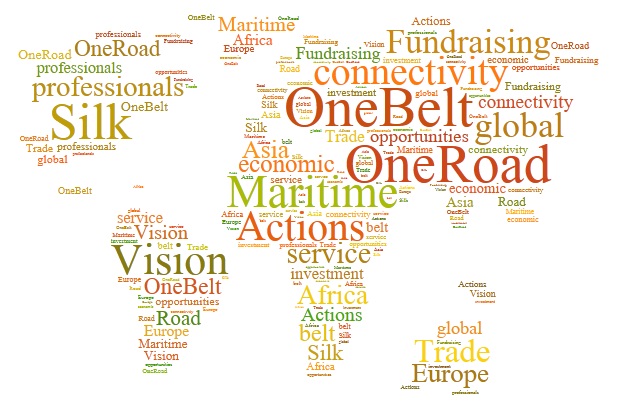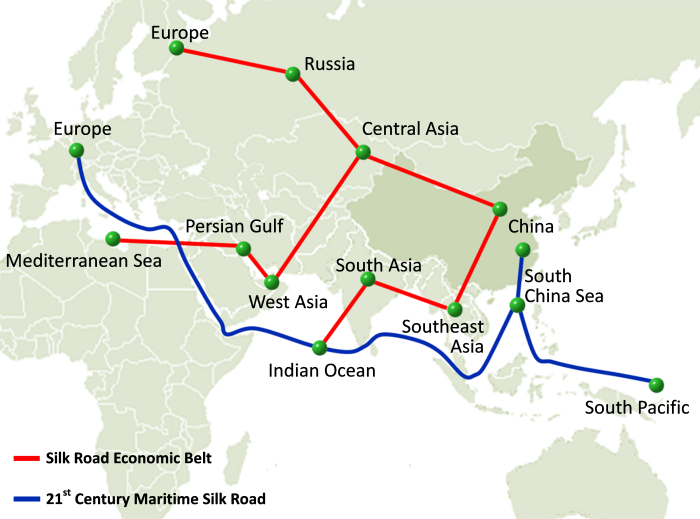ISE12/14-15
| Subject: | financial affairs, economic development, commerce and industry |

- In 2013, the Central Government revealed a strategic vision to foster closer cooperation amongst places far and near lying on two ancient economic corridors, namely "Silk Road Economic Belt" and "21st Century Maritime Silk Road" ("One Belt One Road"). In March 2015, the Central Government further released a broad blueprint, with a view to promoting trade links, capital flows, infrastructural investment and policy coordination among different places in Asia, Europe and Africa. This in particular includes the creation of a new multilateral development bank, Asian Infrastructure Investment Bank ("AIIB"), for infrastructure financing.
- It is also mentioned in the blueprint that the Central Government would leverage on the unique role of Hong Kong and encourage Hong Kong to participate in and contribute to the Belt-Road Initiative. In the 2015 Budget, the Financial Secretary emphasized that Hong Kong should capitalize on the new opportunities created by the Belt-Road Initiative.
- This issue of Essentials takes stock of the latest developments of the Belt-Road Initiative and its potential benefits for Hong Kong. For AIIB and its implications, they are discussed in another piece of Essentials entitled "Asian Infrastructure Investment Bank".
One Belt One Road
- The vision of "One Belt One Road" was pioneered by President Xi Jinping in his visits to Central Asia and Southeast Asia in 2013. The "One Belt" refers to three land routes in the north, comprising (a) the main route connecting China and Europe through Central Asia and Russia; (b) a sideway linking Central Asia to Mediterranean Sea via the Persian Gulf; and (c) another land route linking China to the Indian Ocean via Southeast Asia (Map).1Legend symbol denoting More specifically, the land corridors aims at building a new Eurasian Land Bridge on the one hand, and developing several regional routes like China-Mongolia-Russia, China-Central Asia-West Asia, and China-Indochina Peninsula on the other.
- For the "One Road", it refers to the maritime route in the south, linking coastal China to Europe through South China Sea, Indian Ocean, Persian Gulf, Suez Canal and Mediterranean Sea. Moreover, there is an extension to the South Pacific Ocean via the South China Sea.

- According to an estimate, the two corridors involve more than 60 places and cover 4.4 billion people, accounting for 63% of global population. The aggregate economic value of these places amounts to US$21 trillion (HK$162.8 trillion), representing around 29% of global GDP. Furthermore, the two corridors crisscrossed many developing economies in Central Asia, Southeast Asia, Middle East and Africa which are widely conceived to have emerging economic importance and abundant business opportunities.
- On 28 March 2015, the Central Government released the "Vision and Actions" document on the Belt-Road Initiative, providing more conceptual details. The following are some key features:
(a) Four principles: The Belt-Road Initiative aims at enhancing economic cooperation all over the world, and is not just confined to the places located along these two corridors. Such cooperation is based on four guiding principles, namely (i) openness; (ii) harmony and inclusiveness; (iii) respect of market forces; and (iv) mutual benefits. (b) Five priorities: The blueprint emphasizes "connectivity" in five areas, namely (i) policy coordination amongst governments; (ii) connectivity in regional infrastructural facilities; (iii) more trade and investment flows; (iv) deeper financial cooperation and integration; and (v) increased cultural bondage amongst people across places. (c) Mechanism of cooperation: Apart from strengthening bilateral ties amongst places at all levels, the Belt-Road Initiative also highlights the need of enhanced cooperation in existing multilateral platforms such as Asia Pacific Economic Cooperation (APEC), Asia-Europe Meeting (ASEM), ASEAN Plus China (10+1) and China-Arab States Cooperation Forum (CASCF). (d) Infrastructural projects: So far, construction of new infrastructure is the most discernible form of cooperation and attracts most of the media attention. The coverage of such infrastructural projects are wide ranging, including transport (e.g. roads, railways, ports, airports), power supply and transmission, oil/gas pipelines, fibre-optic networks and other telecommunications, and green and low-carbon projects. (e) Action plan: The Central Government will sign Memoranda of Understanding with relevant places, covering regional cooperation and long-term development plans. It will also provide resources for stronger policy support for the Belt-Road Initiative, including establishment of AIIB and Silk Road Fund. This apart, the Central Government will host more international summits, forums, seminars and expos to promote the Belt-Road Initiative. - It is believed that the Belt-Road Initiative could bring in visible economic benefits to the Mainland. Apart from strengthening bilateral trade between Mainland and places along the two corridors, it can also bring in new opportunities for the Mainland enterprises to "go global". Not only can new markets in the two corridors help absorb some of the excess production capacity in the Mainland, they can also expedite the pace of "renminbi globalization".
- For the developing economies in Asia, the Belt-Road Initiative could also help expedite infrastructural projects which are badly needed for their economic development. According to a study from the Asian Development Bank, annual demand for infrastructural investment in Asia averaged at around US$730 billion (HK$5,660 billion), but annual funding supply from Asian Development Bank is less than 5% of this demand. AIIB under the Belt-Road Initiative is thus welcomed by the developing places in the region.
- Many advanced economies are also interested in the Belt-Road Initiative, eyeing the new opportunities in infrastructural construction and financing. The Belt-Road Initiative may also help them deepen economic relationship with some emerging countries in the region. As such, the top 10 economies in Europe (i.e. Germany, France, United Kingdom, Italy, Russia, Spain, the Netherlands, Turkey, Switzerland and Sweden) have all applied for founding membership in AIIB before the deadline on 31 March 2015.
Potential benefits for Hong Kong
- At the Annual Conference of Boao Forum held in Hainan on 27 March 2015, the Chief Executive suggested the following opportunities for Hong Kong under the Belt-Road Initiative:
• Fundraising hub: Leveraging on its strengths of fully convertible currency, free flows of capital and its status as global financial capital, Hong Kong has the expertise to serve as the fundraising hub for the Belt-Road Initiative. • Offshore renminbi hub: Hong Kong is the largest hub for offshore renminbi business. It can further entrench the hub position by providing global investors with more renminbi services such as bond issuance, trade settlement and asset management services under the Belt-Road Initiative. • Trade and investment hub: Hong Kong now handles some 20% of the international trade of the Mainland. As a "super-connector" between the Mainland and the rest of the world, Hong Kong can benefit from the Belt-Road Initiative through helping overseas companies enter the China market on the one hand, and assisting Chinese enterprises in going global on the other. • Hub for service professionals: Hong Kong is renowned for its excellent professional services, such as legal, banking, accountancy and insurance, architectural and engineering. Professionals in these fields may benefit from opportunities amidst increased connectivity in the region. • Logistics and transportation hub: Hong Kong is well-situated along the Maritime Silk Road. On the back of its long maritime history and a cluster of professional maritime services, it should have competitive strengths in logistics services. On airborne services, as Hong Kong is within reach of major Asian economies within four hours of flight time, it likewise has strong competitiveness. - Meanwhile, the Financial Secretary also suggests that Hong Kong can actively take part in the Belt-Road Initiative as "investors, connectors and supporters". He plans to lead a business delegation later this year to visit some of the places along the two corridors to explore new business opportunities.
- Essentially, "One Belt One Road" is an enlarged form of regional economic cooperation stretching across five continents. The Mainland is now promoting the Belt-Road Initiative through more bilateral visits, like the most recent visit of Russia, Kazakhstan and Belarus by President Xi in early May. These visits aim to lead to more bilateral cooperation agreements under the Initiative.
Prepared by Kari CHU
Research Office
Information Services Division
Legislative Council Secretariat
20 May 2015
Endnote:
References:
| 1. | Asian Development Bank. (2009) Infrastructure for a Seamless Asia.
|
| 2. | Information Services Department. (2015) Speech by Chief Executive at session of Boao Forum for Asia Annual Conference 2015, 27 March 2015.
|
| 3. | Mckinsey & Company. (2011) Asia's $1 trillion infrastructural opportunity.
|
| 4. | National Development and Reform Commission. (2015) Vision and Actions on Jointly Building Silk Road Economic Belt and 21st-Century Maritime Silk Road.
|
| 5. | Trade Development Council. (2015) "One Belt, One Road" Initiative: The Implications for Hong Kong. |